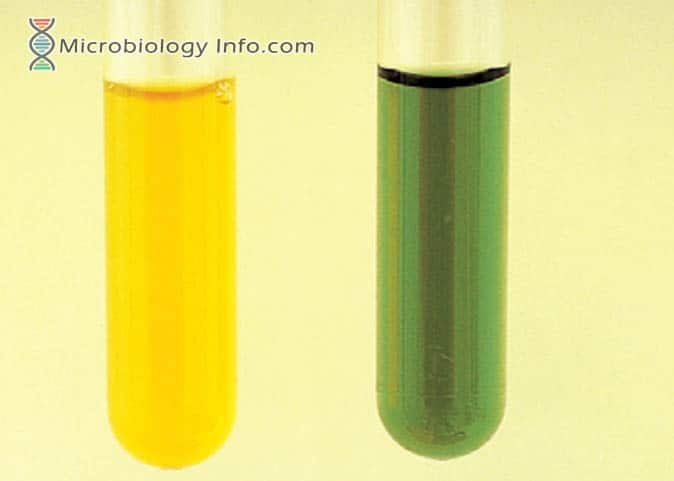Biochemical tests are the tests used for the identification of bacterial species based on the differences in the biochemical activities of different bacteria. Bacterial physiology differs from one type of organism to another.
The ability of bacteria to form organic compounds by metabolizing certain carbohydrates and related compounds is a widely used method for the identification of microorganisms.
One such test is the pyruvate broth test which tests for the ability of some specific species to utilize the substrate pyruvate.
Objective
To determine the ability of an organism to utilize pyruvate to produce acidic end products.
Principle
A source of pyruvate is added to the culture broth to determine whether the microorganism is able to use pyruvate, resulting in the formation of metabolic acids. Acid is produced as a metabolic waste when pyruvate broth is inoculated with bacteria that are capable of metabolizing pyruvate. Acid production causes a decrease in pH which results in a color shift in the medium. Bromothymol blue is the acid-base indicator in the media. It is greenish-blue at an alkaline pH, and shifts to yellow when acid is produced during fermentation of the pyruvate. After incubation, yellow media is indicative of a positive fermentation reaction.
Media:
Pancreatic digest of casein (10 g), pyruvic acid, sodium (10 g), yeast extract (5 g), K2HPO4 (5 g), NaCl (5 g), bromthymol blue (40 g), per 1000 mL, pH 7.3.
Method
- Lightly inoculate the pyruvate broth with an 18- to 24-hour culture of the organism from 5% sheep blood agar.
- Incubate at 35°-37°C in ambient air for 24 to 48 hours.
- Examine for a yellow reaction.
Expected Results
- Positive: A positive pyruvate utilization result is indicated by a color change of the broth from greenish-blue to yellow.
- Negative: A negative pyruvate utilization result is indicated by no color change and the resultant broth remaining a greenish-blue color.

Uses
- The test aids in the differentiation between Enterococcus faecalis (positive) and Enterococcus faecium (negative).
- It can be used as a part of an identication tests for other organisms capable of utilizing pyruvate.
Limitations
- It is recommended that biochemical, immunological, molecular, or mass spectrometry testing be performed on colonies from pure culture for complete identification.
References
- Tille, P. M., & Forbes, B. A. (2014). Bailey & Scott’s diagnostic microbiology (Thirteenth edition.). St. Louis, Missouri: Elsevier.
- Koneman, E.W., et al. Color Atlas and Textbook of Diagnostic Microbiology, J.B. Lippincott Company, Philadelphia, PA.
- https://catalog.hardydiagnostics.com/cp_prod/content/hugo/pyruvatebroth.htm
- https://www.dalynn.com/dyn/ck_assets/files/tech/TP99.pdf
- https://jb.asm.org/content/jb/88/1/4.full.pdf
- http://www.quelab.com/htmleng/2231a.html
Similar Posts:
- Oxidase Test- Principle, Uses, Procedure, Types, Result Interpretation, Examples and Limitations
- Indole Test- Principle, Reagents, Procedure, Result Interpretation and Limitations
- Methyl Red (MR) Test- Principle, Procedure and Result Interpretation
- Nitrate Reduction Test – Principle, Procedure, Uses and Interpretation
